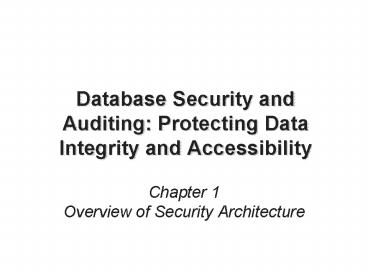Database Security and Auditing: Protecting Data Integrity and Accessibility - PowerPoint PPT Presentation
1 / 20
Title:
Database Security and Auditing: Protecting Data Integrity and Accessibility
Description:
Information security: consists of procedures and measures taken to protect ... Vulnerabilities: kinks in the system that can become threats ... – PowerPoint PPT presentation
Number of Views:131
Avg rating:3.0/5.0
Title: Database Security and Auditing: Protecting Data Integrity and Accessibility
1
Database Security and Auditing Protecting Data
Integrity and Accessibility
- Chapter 1
- Overview of Security Architecture
2
Information Security
- Information security consists of procedures and
measures taken to protect information systems
components - C.I.A. triangle confidentiality, integrity,
availability form the heart of Info security - Security policies must be balanced according to
the C.I.A. triangle
3
Information Security (continued)
4
Confidentiality
- Addresses two aspects of security
- Prevention of unauthorized access
- Information disclosure is based on classification
- Classify company information into levels
- Each level has its own security measures
- Usually based on degree of confidentiality
necessary to protect information - And/or role based access controls
5
Confidentiality (continued)
6
Integrity
- Consistent and valid data, processed correctly,
yields accurate information - Information has integrity if
- It is accurate
- It has not been tampered with
- Read consistency each user sees only his changes
and those committed by other users
7
Integrity (continued)
8
Integrity (continued)
9
Availability
- Systems must be always available to authorized
users - Systems determine what a user can do with the
information - Reasons for a system to become unavailable
- External attacks and lack of system protection
- System failure with no disaster recovery strategy
- Overly stringent and obscure security policies
- Bad implementation of authentication processes
10
Information Security Architecture
- Protects data and information produced from the
data - Model for protecting logical and physical assets
- Is the overall design of a companys
implementation of C.I.A. triangle
11
Information Security Architecture (continued)
12
Information Security Architecture (continued)
- Components include
- Policies and procedures
- Security personnel and administrators
- Detection equipment
- Security programs
- Monitoring equipment
- Monitoring applications
- Auditing procedures and tools
13
Database Security
- Enforce security at all database levels
- Security access point place where database
security must be protected and applied - Data requires highest level of protection data
access point must be small
14
Database Security (continued)
15
Database Security (continued)
- Reducing access point size reduces security risks
- Security gaps points at which security is
missing - Vulnerabilities kinks in the system that can
become threats - Threat security risk that can become a system
breach
16
Database Security (continued)
Value of asset and its likelihood of being
attacked determine - amount of acceptable
security risk - amount the organization will
spend to reduce risk
17
Database Security Levels (continued)
Finest level of Op. Sys. Access Control
Level of Access Control Available With RDBMS
18
Security Methods
19
Security Methods (continued)
20
Database Security Methodology































